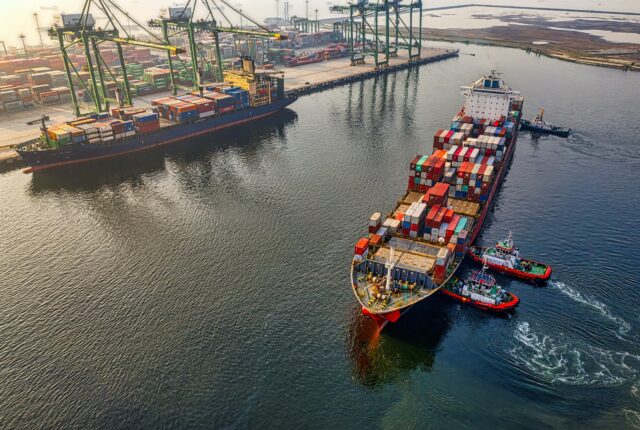
Car Companies Prep for Tariffs in Earnings News
Big automakers are bracing for tariffs. General Motors, Ford, Stellantis and Tesla say they’re strategizing to address possible price increases and supply-chain disruptions.
Automotive regulatory reporter Ryan Felton analyzes the latest earnings results from car companies to explain what they’re doing and what it could mean for customers.
Julia Carpenter hosts this special bonus episode of What’s News in Earnings, where they dig into companies’ earnings reports and analyst calls to find out what’s going on under the hood of the American economy.
Full Transcript
Julia Carpenter: Hey listeners, it’s Wednesday, May 7th. I’m Julia Carpenter for The Wall Street Journal, and this is What’s News in Earnings, our look at some of the big themes standing out this earnings season. Today we’re talking about automakers. It certainly hasn’t been a quiet few months for big automotive companies like Ford, Stellantis, General Motors and Tesla. They’ve been the target of Trump administration tariffs and the back and forth with The White House has dominated the news cycle. So, how are the companies responding and what’ll it mean for customers? Ryan Felton covers automotive regulatory issues and the car company Stellantis for The Wall Street Journal, and he’s here to explain all that’s happening across the sector. Ryan, good to see you.
Ryan Felton: Thanks so much for having me on.
Julia Carpenter: We’ve now seen earning reports from big automakers like Ford, Tesla, General Motors, Stellantis, all four mentioned tariffs. Can you tell me more about how executives addressed this concern and talked about what it means for the future?
Ryan Felton: Hedging is probably the best way to put it. The major automakers pulled back on their forecast for the rest of the year projecting a lot of additional costs in the billions of dollars to compensate for the tariffs, and then just trying to start figuring out how to get production set up in a way to minimize the tariff liability, which I think at this point has definitely been as described as a bit of a challenge, because things are continuing to evolve at the administration and how they’re trying to set this up as well, including as recently as within the past week.
Julia Carpenter: General Motors said they’re expecting $4 billion to $5 billion in tariff costs this year, and that could cut net profit by as much as a quarter. Those are giant numbers. What is GM planning to do about them?
Ryan Felton: Yeah, the main things that they put out were cutting spending for one part and then increasing production where they can. There’s been a lot of talk in recent days in particular from the United Auto Workers, which has a big representation at GM, about how much extra capacity these American automakers already have to boost production. It’s a very simplified way of explaining that extra capacity, but with all that said, GM did say this week that it’s planning to build more profitable pickup trucks at a factory in Indiana and start trying to make more electric vehicles, batteries in the US and then just trim costs wherever else it can.
Julia Carpenter: And Stellantis, which I know you cover, is of course in the midst of this big transition period. They’re still looking for a new CEO, their CEO left late last year. What did the executives share about plans there?
Ryan Felton: Yeah, so they’re still planning to name their CEO at some point before the end of the first half. They say they’re on track for that, but they too are in a difficult position, because they make a lot of their profitable bigger pickup trucks for the market in Mexico, so they have to start thinking about making some changes as to where some of their more popular, more profitable products are made and finding ways to trim costs on those in particular. At the same time, there have said that they’re planning to reopen a factory in Illinois, which it’s not something that you can just do overnight.
Julia Carpenter: In thinking about everything you’ve just described with Stellantis, a lot of these challenges seem to have broader implications.
Ryan Felton: The way that I always think about cars in the broadest sense is it’s the second-biggest thing that most people buy. People in bigger cities may not need a car, but 80%, 90% of the public does. It really complicates things for a lot of consumers downstream, and that partially explains, I think, why you saw sales spike the way that they did the past couple of months. There was some effort by companies to offer promotions and the like to reel people in before this essentially necessary item, a car, gets even more expensive.
Julia Carpenter: Tesla reported pretty weak results, some of the weakest posted in years. 71% drop in net income during its most recent quarter, and of course, Elon Musk has been spending more time at The White House. What’s happening with Tesla? How is this impacting the company and what is it saying it’s going to do next?
Ryan Felton: That’s the most standout item from their call is that Elon says he’s going to be devoting more time to the company, but at the same time, they still are preparing to launch a new updated version of the Model Y SUV, which is their top-selling vehicle. So that was partially what they said was to explain for the sales drop-off, but still at the same time, a lot of people are starting to come around to the idea that they’ve basically had the same models for years now, and that maybe is starting to impact consumer appetite for it. But that said, Tesla told investors that it’s planning to introduce what they’re calling more affordable models, which has been a bit of a mystery what exactly that is. It could be a brand new car possibly what it was long hoped for, but now the expectation is that it’ll be an even more stripped down version of the Model Y and Model 3.
Julia Carpenter: Ryan, I wanted to ask you about the possibility of supply chain disruption. Ford mentioned it on their earnings call, it’s a big concern for a lot of consumers, a concern for investors. Are we seeing it happen now or is this still a concern for the future?
Ryan Felton: Thinking about how the semiconductor crisis kind of played out, it was something that was percolating for a while and then it just blew up. What we’ve been seeing and talking with folks in the industry here is there has been a lot of back and forth for the better part of two months now between companies over who’s paying what on tariff. Are you paying everything? Am I paying everything? Are we splitting it? If those discussions break down, that’s where you can start to have hiccups in supply chain challenges. One supplier, this isn’t just hyperbole, it’s been proven over time, one supplier can really wreak havoc on the entire industry. There’s a lot of really specialized components and only so many companies that make them, and so if one goes down, it can immediately become a challenge.
Julia Carpenter: Last question for you, Ryan. Looking ahead, can we expect to see the tariffs passed on to consumers? And what have companies had to say about that and what they’re going to do about it?
Ryan Felton: So far, the way that companies have said they’re going to handle this is we’re not going to raise prices for now. That’s because most companies have, roughly speaking, two months worth of unsold new cars on dealer lots, so that kind of gives you a bit of a runway to start figuring out contingencies. There’s reason to think things could play out where consumers may not see a significant jump. This changed, for example, to the auto parts tariff that the Trump administration introduced last week. It made the tariff on a lot of auto parts within this North American region exempt from the tariffs, at least for now. So if that stays in place and a lot of these parts continue to be exempt, I think it’s possible you could see the damage limited. But that said, thinking of a company like Subaru for example, or Volvo’s another good example, Volvo’s earnings were pretty bleak. Customers who like very import-heavy carmakers may be the ones who see the issues first, because unlike a company such as Ford or GM, they have less levers to pull to really figure out how to maneuver this.
Julia Carpenter: And that was What’s News in Earnings. Today’s show was produced by Charlie Duffield and Pierre Bienaimé with Deputy Editor Chris Zinsli. Later today we’ll have the PM edition of What’s News out for you as usual, and we’ll be back later this earnings season diving into another industry. Until then, I’m Julia Carpenter. Have a great day.
Big automakers like General Motors, Ford, Stellantis, and Tesla are bracing for the impact of new tariffs, strategizing to address potential price increases and supply-chain disruptions. These measures are expected to significantly affect freight logistics, compelling companies to reassess their operations and adapt to the evolving trade landscape.
Source: Article






